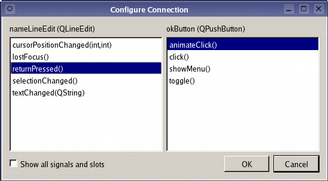Signal Slot Reference
What is 5G NR reference signals?

Signals and slots. Instead of having observable objects and observers, and registering them, Qt provides two high level concepts: signals and slots. A signal is a message that an object can send, most of the time to inform of a status change. A slot is a function that is used to accept and respond to a signal. Uplink SRS is a reference signal sent by the UE, used by the eNb to evaluate the channel quality of uplink path and uplink timing transmission This is a simplified view of the SRS. The first line, for example, reads as follows: If the program passes the argument by const reference to the signal and also by const reference to the slot, there are no copies for a direct connection and one copy for a queued connection.

The reference signals are special signals that exists only at PHY layer. Reference signals does not carry any information for users. The purpose of the Reference Signal is to deliver the reference point for the downlink power. 5G NR reference signals somewhat different from LTE.
What is new in 5G NR reference signals compared to 5G?
- There is no cell specific reference signals (C-RS) in 5G.
- A new signal PTRS has been introduced in 5G.
- In contrast to LTE, the reference signals in NR are transmitted only when necessary.
- DMRS has been introduced for both uplink and downlink channels.
NR introduces the following four main reference signals.
Signal Slot Reference Generator

The four main reference signals are:
- The demodulation reference signal (DMRS).
- Phase-tracking reference signal (PTRS).
- Sounding reference signal (SRS).
- Channel-state information reference signal (CSI-RS).

DMRS in 5G: The demodulation reference signal.
DMRS is UE specific and it can be beam formed, confined in a schedule resource. It is transmitted only when needed both in DL and UL directions. To support multiple-layer MIMO transmission, multiple orthogonal DMRS ports can be scheduled, one for each layer. Additionally, multiple orthogonal DMRSs can be allocated to support MIMO transmission.
For initial decoding network provides DMRS information early on. This information is provided by network only occasionally for low speed scenarios in which the channel shows little change. There is a concept of additional DMRS. In high mobility scenarios to track fast changes in channel , Network might increase the rate of transmission of DMRS signal. This increase in rate DMRS called additional DMRS. For low-speed scenarios, DMRS uses low density in the time domain. However, for high-speed scenarios, the time density of DMRS is increased to track fast changes in the radio channel.
PTRS in 5G: Phase-tracking reference signal.
MmWave is very high frequency wave. As the frequency of operation increases, the phase noise of a transmitter also increases. So PTRS plays an important role here to minimize the effect of the oscillator phase noise on system performance. PTRS is associated with one DMRS port during transmission. It is present both in uplink (in PUSCH) and down link (in PDSCH) channels. One of the main degradation caused by phase noise in an OFDM signal is an identical phase rotation of all the subcarriers, known as common phase error (CPE).
Because of phase noise properties and it’s design, PTRS has low density in frequency domain and high density in time domain, since the phase rotation produced by CPE is identical for all sub-carriers within an OFDM symbol, but there is low correlation of phase noise across OFDM symbols. PTRS is UE-specific, confined in a scheduled resource and can be beam formed.
SRS in 5G: Sounding reference signal.
It is a reference signal from UE to gNB. gNB uses this SRS signal to figure out the channel quality of uplink path for each subsections of frequency region. The SRS is transmitted in UL to perform CSI measurements mainly for scheduling, link adaptation, Massive MIMO, and beam management. In time domain, it spans 1/2/4 consecutive symbols and they are mapped within last six symbols of the slot. We can have multiple SRS symbols which will allow coverage extension and increased sounding capacity. Most probably the SRS will have a modular and flexible design so that it can support different procedures and UE capabilities.
CSI-RS in 5G: Channel-state information reference signal.
- It is a DL only signal.
- Like C-RS LTE, it is used for DL CSI acquisition.
- UE receives this signal to estimate the channel quality and report channel quality information back to the gNB.
- It will be used for RSRP measurements during mobility and beam management.
- CSI-RS will be used for frequency and time tracking.
- It will be used for demodulation and UL reciprocity based precoding.
- CSI-RS is configured specific to UE. However multiple users can share the same resource.
- The configuration of CSI-RS is flexible according to 5G NR standards.
- A resource can be configured with up to 32 ports.
- Depending upon the configured number of ports, CSI-RS resource may start at any OFDM symbol of the slot.
- Resources usually occupies 1/2/4 OFDM symbols .
- Because of DCI triggering, CSI-RS can be periodic, semi-persistent or aperiodic.
- CSI-RS can either be periodic or aperiodic for time/frequency tracking.
- CSI-RS always transmitted in bursts of two or four symbols. And they are spread across one or two slots.
C++ Signal Slot
Please sign up the 5g discussion forum by clicking the below link and share your knowledge and ask any questions you have.
Link: 5g community/5g discussion forum.